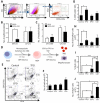Erythropoiesis from human embryonic stem cells through erythropoietin-independent AKT signaling
- PMID: 24677652
- PMCID: PMC4037366
- DOI: 10.1002/stem.1677
Erythropoiesis from human embryonic stem cells through erythropoietin-independent AKT signaling
Abstract
Unlimited self renewal capacity and differentiation potential make human pluripotent stem cells (PSC) a promising source for the ex vivo manufacture of red blood cells (RBCs) for safe transfusion. Current methods to induce erythropoiesis from PSC suffer from low yields of RBCs, most of which are immature and contain embryonic and fetal rather than adult hemoglobins. We have previously shown that homodimerization of the intracellular component of MPL (ic-MPL) induces erythropoiesis from human cord blood progenitors. The goal of this study was to investigate the potential of ic-MPL dimerization to induce erythropoiesis from human embryonic stem cells (hESCs) and to identify the signaling pathways activated by this strategy. We present here the evidence that ic-MPL dimerization induces erythropoietin (EPO)-independent erythroid differentiation from hESC by inducing the generation of erythroid progenitors and by promoting more efficient erythroid maturation with increased RBC enucleation as well as increased gamma:epsilon globin ratio and production of beta-globin protein. ic-MPL dimerization is significantly more potent than EPO in inducing erythropoiesis, and its effect is additive to EPO. Signaling studies show that dimerization of ic-MPL, unlike stimulation of the wild type MPL receptor, activates AKT in the absence of JAK2/STAT5 signaling. AKT activation upregulates GATA-1 and FOXO3 transcriptional pathways with resulting inhibition of apoptosis, modulation of cell cycle, and enhanced maturation of erythroid cells. These findings open up potential new targets for the generation of therapeutically relevant RBC products from hPSC.
Keywords: AKT; Erythropoiesis; Erythropoietin; GATA-1; Human embryonic stem cells; MPL.
© 2014 AlphaMed Press.
Figures







Similar articles
-
Novel pathways to erythropoiesis induced by dimerization of intracellular C-Mpl in human hematopoietic progenitors.Stem Cells. 2012 Apr;30(4):697-708. doi: 10.1002/stem.1046. Stem Cells. 2012. PMID: 22290824 Free PMC article.
-
Lnk inhibits erythropoiesis and Epo-dependent JAK2 activation and downstream signaling pathways.Blood. 2005 Jun 15;105(12):4604-12. doi: 10.1182/blood-2004-10-4093. Epub 2005 Feb 10. Blood. 2005. PMID: 15705783 Free PMC article.
-
Erythropoietin stimulates phosphorylation and activation of GATA-1 via the PI3-kinase/AKT signaling pathway.Blood. 2006 Feb 1;107(3):907-15. doi: 10.1182/blood-2005-06-2516. Epub 2005 Oct 4. Blood. 2006. PMID: 16204311 Free PMC article.
-
The role of tyrosine phosphorylation in proliferation and maturation of erythroid progenitor cells--signals emanating from the erythropoietin receptor.Eur J Biochem. 1997 Nov 1;249(3):637-47. doi: 10.1111/j.1432-1033.1997.t01-1-00637.x. Eur J Biochem. 1997. PMID: 9395308 Review.
-
Control of erythropoiesis by erythropoietin and stem cell factor: a novel role for Bruton's tyrosine kinase.Cell Cycle. 2004 Jul;3(7):876-9. Epub 2004 Jul 2. Cell Cycle. 2004. PMID: 15254422 Review.
Cited by
-
Organoid-Induced Differentiation of Conventional T Cells from Human Pluripotent Stem Cells.Cell Stem Cell. 2019 Mar 7;24(3):376-389.e8. doi: 10.1016/j.stem.2018.12.011. Epub 2019 Jan 17. Cell Stem Cell. 2019. PMID: 30661959 Free PMC article.
-
Gigantol Suppresses Cancer Stem Cell-Like Phenotypes in Lung Cancer Cells.Evid Based Complement Alternat Med. 2015;2015:836564. doi: 10.1155/2015/836564. Epub 2015 Aug 3. Evid Based Complement Alternat Med. 2015. PMID: 26339272 Free PMC article.
-
An Overview of Different Strategies to Recreate the Physiological Environment in Experimental Erythropoiesis.Int J Mol Sci. 2020 Jul 24;21(15):5263. doi: 10.3390/ijms21155263. Int J Mol Sci. 2020. PMID: 32722249 Free PMC article. Review.
-
Analyses of erythropoiesis from embryonic stem cell-CD34+ and cord blood-CD34+ cells reveal mechanisms for defective expansion and enucleation of embryomic stem cell-erythroid cells.J Cell Mol Med. 2022 Apr;26(8):2404-2416. doi: 10.1111/jcmm.17263. Epub 2022 Mar 5. J Cell Mol Med. 2022. PMID: 35249258 Free PMC article.
-
Evolving insights into the synergy between erythropoietin and thrombopoietin and the bipotent erythroid/megakaryocytic progenitor cell.Exp Hematol. 2016 Aug;44(8):664-8. doi: 10.1016/j.exphem.2015.11.010. Epub 2016 Jan 8. Exp Hematol. 2016. PMID: 26773569 Free PMC article. Review.
References
-
- Carson J, Grossman B, Kleinman S, et al. Red Blood Cell Transfusion: A Clinical Practice Guideline From the AABB. Annals of Internal Medicine. 2012;157:49–U95. - PubMed
-
- Olivier E, Qiu C, Velho M, et al. Large-scale production of embryonic red blood cells from human embryonic stem cells. Experimental Hematology. 2006;34:1635–1642. - PubMed
-
- Kendall RG. Erythropoietin. Clin Lab Haematol. 2001;23:71–80. - PubMed
Publication types
MeSH terms
Substances
Grants and funding
LinkOut - more resources
Full Text Sources
Other Literature Sources
Research Materials
Miscellaneous

